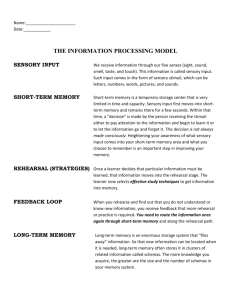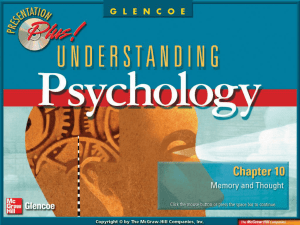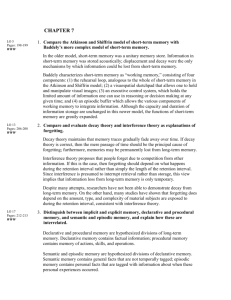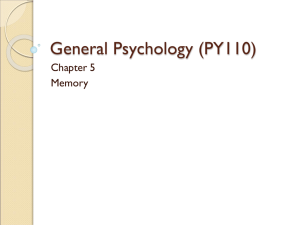Long-Term Memory
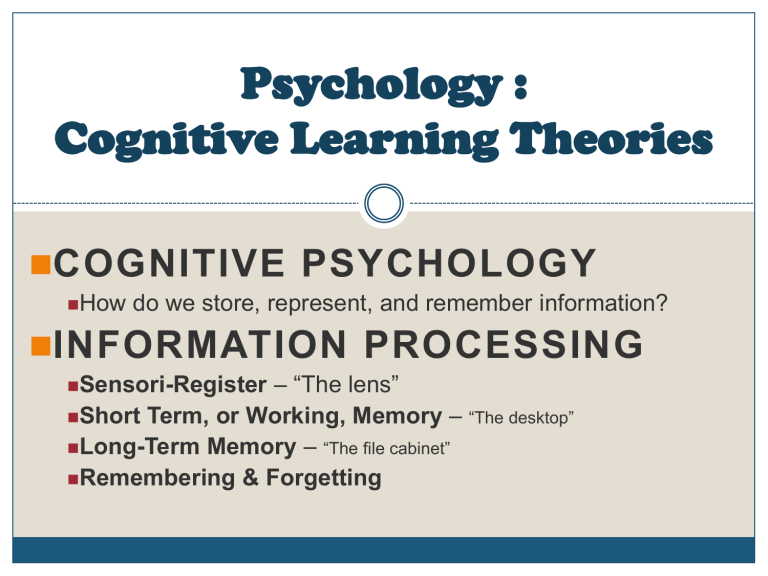
Psychology :
Cognitive Learning Theories
COGNITIVE PSYCHOLOGY
How do we store, represent, and remember information?
INFORMATION PROCESSING
Sensori-Register – “The lens”
Short Term, or Working, Memory –
“The desktop”
Long-Term Memory –
“The file cabinet”
Remembering & Forgetting
We can now see how making strong connections in your brain works
The more you make connections between new material and old material the easier it will be for you to remember.
Cognitive Psychology
Information Processing Model of Learning
Information Processing Model of Learning compares our brain to the computer
We take in information
We perform operations on the information
We store, and later, locate the information
We use the knowledge (information) we have to respond and solve problems.
Information Processing Model
Executive Control Processes – Self-Regulated Learning
(Attention, Strategy Selection, Monitoring Understanding)
U
L
I
S
T
I
M
O
U
T
S
I
D
E
Rehearsal
Sensory
Register
Attention is the
Key
Decay
Permanent Loss
Short-Term
Memory
(Retaining
Information
)
Elaboration &
Organization
Working
Memory
Initial
Processing
(Chunking, Reworking,
Organizing info for
Placement into Long
Term Memory)
Retrieval &
Reconstruction
Decay & Interference
Permanent Loss
Long
Term
Memory
Forgetting
Lost but possible recovery
Information Processing Model
The Computer Metaphor
Sensory Register
Memory
(instantaneous)
Short-Term or
Working
Memory
(internal RAM)
Long-Term
Memory
(Hard Drive)
Information Processing Model
Executive Control Processes – Self-Regulated Learning
(Attention, Strategy Selection, Monitoring Understanding)
U
L
I
S
T
I
M
O
U
T
S
I
D
E
Rehearsal
Sensory
Register
Attention is the
Key
Decay
Permanent Loss
Short-Term
Memory
(Retaining
Information
)
Elaboration &
Organization
Working
Memory
Initial
Processing
(Chunking, Reworking,
Organizing info for
Placement into Long
Term Memory)
Retrieval &
Reconstruction
Decay & Interference
Permanent Loss
Long
Term
Memory
Forgetting
Lost but possible recovery
Just to remind you
Here is our goal … to make connections
The more you make connections between new material and old material the easier it will be for you to remember.
Connections come from good learning strategies
Sensory Register – Attention is the Key
Many students believe that they can Multi-Task but the research on this clearly shows we are not able to
Multi-Task. We can only pay attention to one thing at a time.
Sensory
Be sure to read the examples in your textbook and on-line. There will be questions on the test on the research on Multi-Tasking
Register
Attention is the
Key
Information Processing Model
Executive Control Processes – Self-Regulated Learning
(Attention, Strategy Selection, Monitoring Understanding)
U
L
I
S
T
I
M
O
U
T
S
I
D
E
Rehearsal
Sensory
Register
Attention is the
Key
Decay
Permanent Loss
Short-Term
Memory
(Retaining
Information
)
Elaboration &
Organization
Working
Memory
Initial
Processing
(Chunking, Reworking,
Organizing info for
Placement into Long
Term Memory)
Retrieval &
Reconstruction
Decay & Interference
Permanent Loss
Long
Term
Memory
Forgetting
Lost but possible recovery
Short-Term Memory or
Working Memory
Short-Term is VERY Short Term - Seconds
Two Purposes
1.
Retaining Information you plan on disposing
This is when the purpose is short-term memory
2.
Working on information (working memory)
When purpose is to transfer information to long-term memory
Information Processing Model
Executive Control Processes – Self-Regulated Learning
(Attention, Strategy Selection, Monitoring Understanding)
U
L
I
S
T
I
M
O
U
T
S
I
D
E
Sensory
Register
Rehearsal
Short-Term
Memory
(Retaining
Information
)
Elaboration &
Organization
Attention is the
Key
Decay
Permanent Loss
Initial
Processing
Working
Memory
(Chunking, Reworking,
Organizing info for
Placement into Long
Term Memory)
Retrieval &
Reconstruction
Decay & Interference
Permanent Loss
Long
Term
Memory
Forgetting
Lost but possible recovery
Short-Term Memory or Working Memory
Short-Term Memory is Limited in 2 Ways
1.
1.
Short-Term
Memory
(Retaining
Information
)
How long un-rehearsed information can be held in short-term memory (20-30 seconds)
Working
Memory
How much information may be held in shortterm memory. (5-9 bit of information)
The 7+or-2 dictum can be overcome with Chunking
(Chunking, Reworking,
Organizing info for
Placement into Long
Term Memory)
Retaining Information in Short-Term Memory vs.
Using Working Memory to Solve Problems
Since STM holds so little, for so short a time, we have to use strategies to “think” because this is occurring in STM.
Maintenance Rehearsal –
Repeating the information in your mind
Phonological Loop
– rehearsal of words and sounds in STM
Visuospatial Sketchpad – manipulating images in STM (e.g., You are traveling north, then turn right for a mile, then turn right, and then left…)
Elaborative Rehearsal –
Connecting what you need to something you already know (e.g., How does CH 7 information compare to CH2 ? How can I use SRL to enhance learning in LTM by engagement in STM?)
Chunking –
The 7+/-2 limits how much we can maintain in STM so how do we remember a phone number when we have to include the area code?
Long-Term Memory vs Short-Term Memory
STM
Fast and Automatic
1.
LTM
Slow & Requires Work
1. Input 1.
2. Capacity 2.
Very Limited (7+-2) 2.
Unlimited
3. Duration 3.
Very brief (20-30 sec) 3.
Practically unlimited
4. Contents
5. Retrieval
4.
5.
6. Maintenance 6.
Words, Images
NO retrieval time. It is present tense
4.
5.
High maintenance –
Rehearse it or lose it
6.
Propositional network, schemas, episodes
Depends on how info was organized
Low Maintenance, it’s there forever
Organization is the key to the retrieval of information from Long Term Memory
Explicit and Implicit Memory Systems
Extras for understanding how we remember and think
Explicit Memory
(
Conscious)
Episodic
Memory
Experience
Semantic
Memory
Facts,
Knowledge
Memory
Implicit Memory
(Unconscious)
Classical
Conditioning
Procedural
Memory
Skills, habits, tacit rules
Priming
Implicit activation of concepts
Remembering and Forgetting in LTM
3 causes of forgetting in
LTM
Lack of organization when information is stored
Weak connections to prior learning
Interference –
We will talk about this next class
Long
Term
Memory
Storing and Retrieving Information
Elaboration is adding meaning to new information by connecting it to existing information.
Organization adds a structure to new information which will guide the learner to individual parts.
Context in which we learn can impact retrieval by adding physical and emotion cues.
